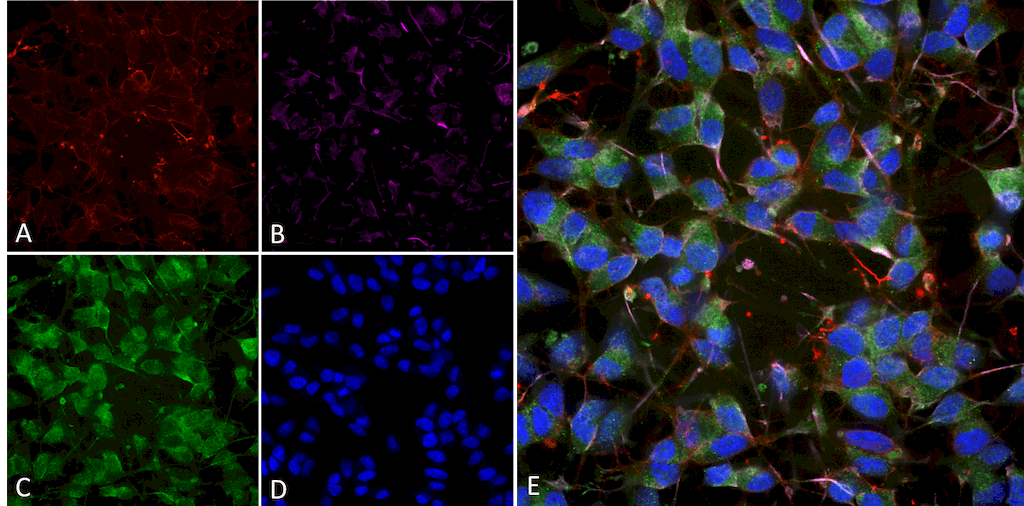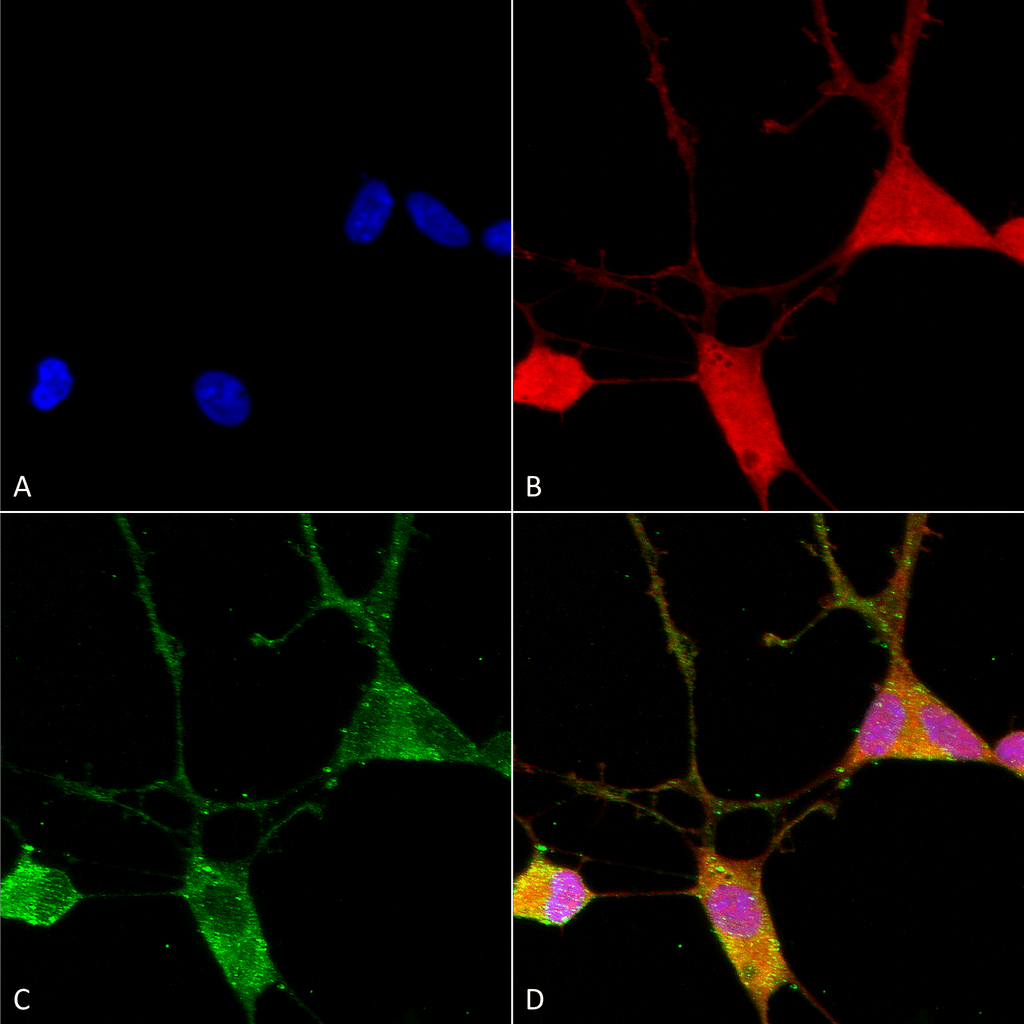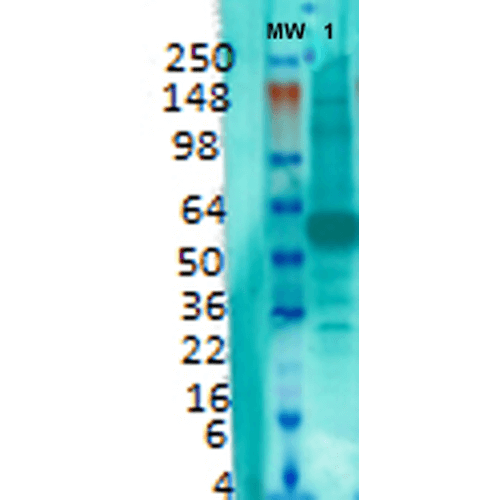Anti-VGLUT1 Transporter [Clone S28-9]
Anti-VGLUT1 Transporter [Clone S28-9]
Product No.: 56514
- -
- -
Clone S28-9 Target VGlut1 Transporter Formats AvailableView All Product Type Monoclonal Alternate Names VGluT1, Brain-specific Na(+-dependent inorganic phosphate cotransporter, Solute carrier family 17 member 7 Isotype Mouse IgG1 Applications IHC , WB |
Data
 Immunocytochemistry/Immunofluorescence analysis using Mouse Anti-VGLUT1 Monoclonal Antibody, Clone S28-9 (56514). Tissue: Differentiated SH-SY5Y. Species: Human. Primary Antibody: Mouse Anti-VGLUT1 Monoclonal Antibody (56514) at 1:100. Secondary Antibody: AlexaFluor 488. Counterstain: phalloidin (Alexa 647, red), beta tubulin (Anti-beta III Tubulin Ab, Alexa 555, magenta) Hoechst (blue). (A) Phalloidin (B) Anti-beta III Tubulin Ab. (C) VGLUT1 Antibody. (D) Hoechst (E) Composite.
Immunocytochemistry/Immunofluorescence analysis using Mouse Anti-VGLUT1 Monoclonal Antibody, Clone S28-9 (56514). Tissue: Differentiated SH-SY5Y. Species: Human. Primary Antibody: Mouse Anti-VGLUT1 Monoclonal Antibody (56514) at 1:100. Secondary Antibody: AlexaFluor 488. Counterstain: phalloidin (Alexa 647, red), beta tubulin (Anti-beta III Tubulin Ab, Alexa 555, magenta) Hoechst (blue). (A) Phalloidin (B) Anti-beta III Tubulin Ab. (C) VGLUT1 Antibody. (D) Hoechst (E) Composite. Immunocytochemistry/Immunofluorescence analysis using Mouse Anti-VGLUT1 Monoclonal Antibody, Clone S28-9 (56514). Tissue: Neuroblastoma cells (SH-SY5Y). Species: Human. Fixation: 4% PFA for 15 min. Primary Antibody: Mouse Anti-VGLUT1 Monoclonal Antibody (56514) at 1:100 for overnight at 4°C with slow rocking. Secondary Antibody: AlexaFluor 488 at 1:1000 for 1 hour at RT. Counterstain: Phalloidin-iFluor 647 (red) F-Actin stain; Hoechst (blue) nuclear stain at 1:800, 1.6mM for 20 min at RT. (A) Hoechst (blue) nuclear stain. (B) Phalloidin-iFluor 647 (red) F-Actin stain. (C) VGLUT1 Antibody (D) Composite.
Immunocytochemistry/Immunofluorescence analysis using Mouse Anti-VGLUT1 Monoclonal Antibody, Clone S28-9 (56514). Tissue: Neuroblastoma cells (SH-SY5Y). Species: Human. Fixation: 4% PFA for 15 min. Primary Antibody: Mouse Anti-VGLUT1 Monoclonal Antibody (56514) at 1:100 for overnight at 4°C with slow rocking. Secondary Antibody: AlexaFluor 488 at 1:1000 for 1 hour at RT. Counterstain: Phalloidin-iFluor 647 (red) F-Actin stain; Hoechst (blue) nuclear stain at 1:800, 1.6mM for 20 min at RT. (A) Hoechst (blue) nuclear stain. (B) Phalloidin-iFluor 647 (red) F-Actin stain. (C) VGLUT1 Antibody (D) Composite. Immunohistochemistry analysis using Mouse Anti-VGLUT1 Monoclonal Antibody, Clone S28-9 (56514). Tissue: spinal cord. Species: Mouse. Fixation: 4% PFA. Primary Antibody: Mouse Anti-VGLUT1 Monoclonal Antibody (56514) at 1:500 for 16 hours at RT. Secondary Antibody: Alexa Fluor 555 Donkey Anti-Mouse (red) at 1:2000 for 2 hours at RT. Counterstain: NeuN neuronal stain (green). Magnification: 20X. Courtesy of: Leilei Wang, Ph.D. UT Southwestern Medical Center at Dallas.
Immunohistochemistry analysis using Mouse Anti-VGLUT1 Monoclonal Antibody, Clone S28-9 (56514). Tissue: spinal cord. Species: Mouse. Fixation: 4% PFA. Primary Antibody: Mouse Anti-VGLUT1 Monoclonal Antibody (56514) at 1:500 for 16 hours at RT. Secondary Antibody: Alexa Fluor 555 Donkey Anti-Mouse (red) at 1:2000 for 2 hours at RT. Counterstain: NeuN neuronal stain (green). Magnification: 20X. Courtesy of: Leilei Wang, Ph.D. UT Southwestern Medical Center at Dallas. - -
- -
Antibody DetailsProduct DetailsReactive Species Human ⋅ Mouse ⋅ Rat Host Species Mouse Immunogen Fusion protein corresponding to aa 493-560 (cytoplasmic C-terminus) of rat VGlut1 (accession no. NP_446311). Product Concentration 1.0 mg/ml Formulation PBS, pH 7.4, 50% glycerol, 0.09% sodium azide.Purified by Protein G affinity chromatography. State of Matter Liquid Product Preparation Purified by Protein G affinity chromatography Storage and Handling This antibody is stable for at least one (1) year at -20°C. Avoid multiple freeze-thaw cycles. Regulatory Status For in vitro investigational use only. Not for
use in therapeutic or diagnostic procedures. Country of Origin USA Shipping Next Day 2-8°C Applications and Recommended Usage? Quality Tested by Leinco Immunoblotting: use at 1-2ug/mL. A band of ~52kDa is detected.
Immunohistochemistry: use at 1-5ug/mL. These are recommended concentrations. Enduser should determine optimal concentrations for their applications. Positive control: rat brain lysate. Each investigator should determine their own optimal working dilution for specific applications. See directions on lot specific datasheets, as information may periodically change. DescriptionDescriptionSpecificity This antibody recognizes human, mouse,
and rat VGlut1. It does not cross-react
with VGlut2. Background VGlut1 is expressed in a subset of glutamate neurons where it transports glutamate into native synaptic vesicles from the brain. Glutamate transport by VGlut1 is saturated with a K(m) of approximately 2mM. Whereas plasma membrane glutamate transporters recognize both aspartate and glutamate as substrates, VGlut1 recognizes only glutamate. Function Mediates the uptake of glutamate into synaptic vesicles at presynaptic nerve terminals of excitatory neural cells. May also mediate the transport of inorganic phosphate. {PubMed:10938000, PubMed:11001057, PubMed:11698619, PubMed:11698620, PubMed:18080752, PubMed:8202535}. NCBI Gene Bank ID UniProt.org Research Area Neuroscience References & CitationsTechnical ProtocolsCertificate of Analysis |
Formats Available
 Products are for research use only. Not for use in diagnostic or therapeutic procedures.
Products are for research use only. Not for use in diagnostic or therapeutic procedures.



